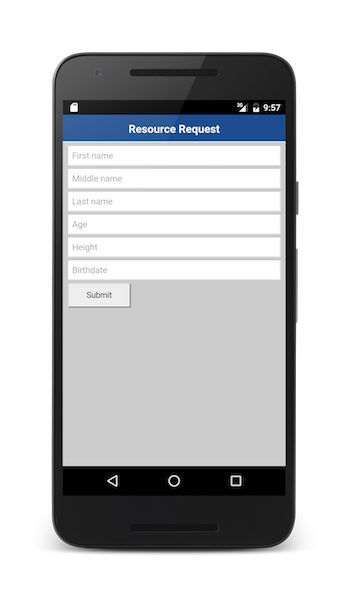Resource request from JavaScript (Cordova, Web) applications
improve this page | report issueOverview
MobileFirst applications can access resources using the WLResourceRequest REST API.
The REST API works with all adapters and external resources.
Prerequisites:
- If you are implementing a Cordova application, ensure you have added the Mobile Foundation SDK to your Cordova application.
- If you are implementing a Web application, ensure you have added the Mobile Foundation SDK to your Web application.
- Learn how to create adapters.
WLResourceRequest
The WLResourceRequest class handles resource requests to adapters or external resources.
Create a WLResourceRequest object and specify the path to the resource and the HTTP method.
Available methods are: WLResourceRequest.GET, WLResourceRequest.POST, WLResourceRequest.PUT and WLResourceRequest.DELETE.
var resourceRequest = new WLResourceRequest(
"/adapters/JavaAdapter/users",
WLResourceRequest.GET
);
- For JavaScript adapters, use
/adapters/{AdapterName}/{procedureName} - For Java adapters, use
/adapters/{AdapterName}/{path}. Thepathdepends on how you defined your@Pathannotations in your Java code. This would also include any@PathParamyou used. - To access resources outside of the project, use the full URL as per the requirements of the external server.
- timeout: Optional, request timeout in milliseconds
Sending the request
Request the resource by using the send() method.
The send() method takes an optional parameter to set a body to the HTTP request, which could be a JSON object or a simple string.
Using JavaScript promises, you can define onSuccess and onFailure callback functions.
resourceRequest.send().then(
onSuccess,
onFailure
)
setQueryParameter
By using the setQueryParameter method, you can include query (URL) parameters in the REST request.
resourceRequest.setQueryParameter("param1", "value1");
resourceRequest.setQueryParameter("param2", "value2");
JavaScript adapters
JavaScript adapters use ordered nameless parameters. To pass parameters to a Javascript adapter, set an array of parameters with the name params:
Note: The
paramsvalue should be a string representation of an array.
resourceRequest.setQueryParameter("params", "['value1', 'value2']");
This should be used with WLResourceRequest.GET.
setHeader
By using the setHeader method, you can set a new HTTP header or replace an existing header with the same name in the REST request.
resourceRequest.setHeader("Header-Name","value");
sendFormParameters(json)
To send URL-encoded form parameters, use the sendFormParameters(json) method instead. This method converts the JSON to a URL encoded string, sets the content-type to application/x-www-form-urlencoded, and sets it as the HTTP body:
var formParams = {"param1": "value1", "param2": "value2"};
resourceRequest.sendFormParameters(formParams);
JavaScript adapters
JavaScript adapters use ordered nameless parameters. To pass parameters to a Javascript adapter, set an array of parameters with the name params:
var formParams = {"params":"['value1', 'value2']"};
This should be used with WLResourceRequest.POST.
For more information about
WLResourceRequest, see the API reference in the user documentation.
The response
Both the onSuccess and onFailure callbacks receive a response object. The response object contains the response data and you can use its properties to retrieve the required information. Commonly used properties are responseText, responseJSON (JSON object, if the response is in JSON) and status (the HTTP status of the response).
In case of request failure, the response object also cotains a errorMsg property.
Depending if using a Java or JavaScript adapter, the response may contain other properties such as responseHeaders, responseTime, statusCode, statusReason, and totalTime.
{
"responseHeaders": {
"Content-Type": "application/json",
"X-Powered-By": "Servlet/3.1",
"Content-Length": "86",
"Date": "Mon, 15 Feb 2016 21:12:08 GMT"
},
"status": 200,
"responseText": "{\"height\":\"184\",\"last\":\"Doe\",\"Date\":\"1984-12-12\",\"age\":31,\"middle\":\"C\",\"first\":\"John\"}",
"responseJSON": {
"height": "184",
"last": "Doe",
"Date": "1984-12-12",
"age": 31,
"middle": "C",
"first": "John"
},
"invocationContext": null
}
Handling the response
The response object is received by the onSuccess and onFailure callback functions.
For example:
onSuccess: function(response) {
resultText = "Successfully called the resource: " + response.responseText;
},
onFailure: function(response) {
resultText = "Failed to call the resource:" + response.errorMsg;
}
Using WLResourceRequest to access external microservices
The WLResourceRequest API can be used to allow mobile apps access to microservices hosted outside of Mobile Foundation. Mobile Foundation facilitates secure calls to microservice or enterprise backend service without involving adapters through Mobile Foundation API Connector. The API Connector, like an adapter, ensures secure invocations based on Mobile Foundation’s OAuth 2.0 mechanism. With API Connector, Mobile Foundation administrator can configure and deploy microservice or enterprise backend service details in Mobile Foundation. The deployed configuration is used by Mobile Foundation runtime to securely call microservice or backend service requests from the mobile app.
Learn how to configure Mobile Foundation API Connector.
To access a microservice URL such as http://mybluemix.net/resorts/cities and the Mobile Foundation runtime backend service is configured as follows
{
"service": "resorts",
"baseUrl":"http://mybluemix.net/resorts"
}
WLResourceRequest can be defined as
var options = { timeout, backendServiceName}
WLResourceRequest request = new WLResourceRequest(url,WLResourceRequest.GET, options);
- url : Relative URL of the microservice endpoint. For example :
cities - method : HTTP method to use. For example :
WLResourceRequest.GET - backendServiceName : Name of the backend service configured on server to fetch data from. For example, resorts.
- timeout : The timeout in milliseconds for this request.
For more information
For more information about WLResourceRequest, refer to the API Reference.

Sample applications
The ResourceRequestWeb and ResourceRequestCordova projects demonstrate a resource request using a Java adapter.
The adapter Maven project contains the Java adapter used during the resource request call.
Click to download the Cordova project.
Click to download the Web project.
Click to download the adapter Maven project.
Sample usage
Follow the sample’s README.md file for instructions.
▲Inclusive terminology note: The Mobile First Platform team is making changes to support the IBM® initiative to replace racially biased and other discriminatory language in our code and content with more inclusive language. While IBM values the use of inclusive language, terms that are outside of IBM's direct influence are sometimes required for the sake of maintaining user understanding. As other industry leaders join IBM in embracing the use of inclusive language, IBM will continue to update the documentation to reflect those changes.